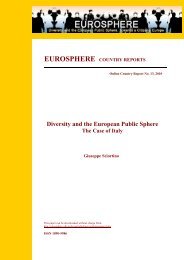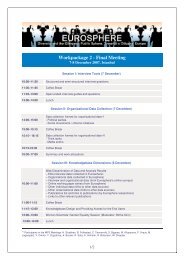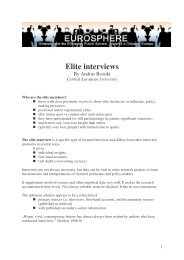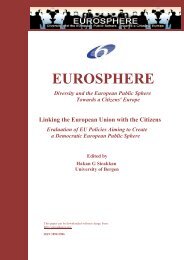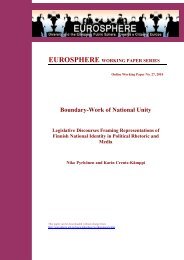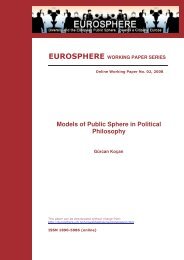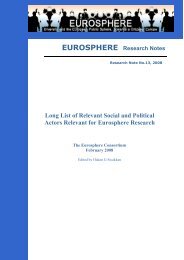Migrants, Minorities, Belongings and Citizenship. Glocalization and ...
Migrants, Minorities, Belongings and Citizenship. Glocalization and ...
Migrants, Minorities, Belongings and Citizenship. Glocalization and ...
You also want an ePaper? Increase the reach of your titles
YUMPU automatically turns print PDFs into web optimized ePapers that Google loves.
have a dominant sense of transnational belonging. Examining these respondents’<br />
responses to the in-depth interview questions, one may state that they have primarily an<br />
ethnic-transnational belonging; that is, a diasporic belonging which also comprises a high<br />
level of loyalty to their country of residence/citizenship. Both high <strong>and</strong> low scores on this<br />
dimension represent an openness beyond the boundaries of the nation state. However, in<br />
contrast to the high-scorers, the respondents who score low on this dimension have weak<br />
communal (ethnic <strong>and</strong>/or religious), national <strong>and</strong> transnational belongings <strong>and</strong> high<br />
political, individual, gender, global, <strong>and</strong> European belongings. They have a sense of<br />
belonging to a civic <strong>and</strong> religiously/ethnically open humanity, world <strong>and</strong> Europe. This<br />
dimension accounts for 20,17% of the total variance.<br />
Dimension 3: Universalist-cosmopolitan versus gendered-territorial belonging<br />
The high-scorers on this dimension are universalist-cosmopolitans. They identify with the<br />
globe, humanity <strong>and</strong> Europe. They regard both their own <strong>and</strong> others’ belongings related<br />
to gender <strong>and</strong> sexuality as irrelevant, <strong>and</strong> identify themselves primarily as humans rather<br />
than men, women, citizens of a country or member of a group (“national belonging”<br />
characterizes this dimension less). In other words, their sense of belonging is based on<br />
boundary transcending references of identification. Their sense of belonging barely<br />
comprises any group belonging. On the other h<strong>and</strong>, those who score low on this<br />
dimension have a moderately strong group belonging in terms of their gender, sexuality,<br />
<strong>and</strong> territoriality. A closer examination of interviews notes of the group of respondents<br />
with low scores indicated that the majority these were women who scored low on global<br />
belonging variable. Dimension 3 accounts for 15% of the total variance.<br />
Dimension 4: Political belonging<br />
There is a single dominant variable in this dimension – political belonging. “Political<br />
belonging” clusters in this dimension – to a limited extent – with ethnic, gender, sexual,<br />
individual, <strong>and</strong> transnational belongings. In other words, this dimension is about certain<br />
“problematic” issues in western politics such as minority, gender, gays/lesbians, etc. A<br />
closer examination of the respondents’ profiles indicated that this dimension is primarily<br />
<strong>and</strong> almost exclusively about the degree of respondents’ self-identification as a political<br />
persons. Since the values of the three negative loadings on this dimension are much<br />
smaller than that of “political belonging”, this dimension can be interpreted as unipolar –<br />
indicating the degree of the respondents’ political belonging with a focus on ethnicity,<br />
gender, sexuality, <strong>and</strong> ethnic transnationalism. Dimension 4 accounts for 11,13% of the<br />
total variance.<br />
70



